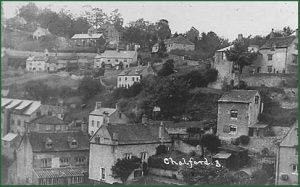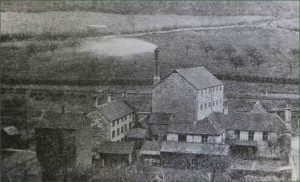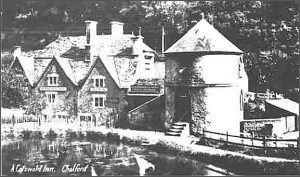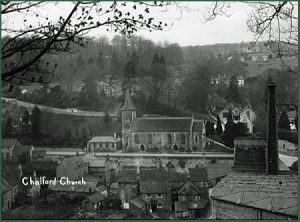Chalford grew up where the old drovers’ road (the Calfway) between Bisley and Minchinhampton crossed the River Frome. The modern main road dates only from 1814-1815, the valley bottom being too marshy for earlier road-building. The Calfway descended the hill beside Millswood (the lane that leads beside Christ Church School) and continued up Hyde Hill. There were three other fords along the valley: Stoneford by Halliday’s Mill, opposite Tankard’s Spring and by the Valley Inn (later Stephen’s Bridge).
The origins of the first part of the village’s name are disputed – does it come from Calf-ford, or from Cealc (Anglo Saxon ‘chalk’, i.e. limestone)-ford? Most of the village lies within the ancient parish of Bisley, but property on the far side of the Frome (e.g. St Mary’s Mill and Cowcombe Hill) historically belonged to Minchinhampton parish.

The fast-running Frome and the abundance of springs proved ideal for the establishing of water mills.The Domesday Book records five mills in Bisley parish – it is assumed that at least some of these were in Chalford.One of the earliest was near the main ford, where Chalford Place now stands. By the Middle Ages and Tudor period, there were a number of woollen mills along the valley, either side of the waterway, in both parishes. Cloth workers and weavers also worked from home, in cottages built up the steep south face of the valley. It is said that each cottage was built with stone quarried out from the hillside behind it – leaving a platform at the rear for the next cottage to occupy. Narrow footpaths link the houses. This gives the village its distinctive ‘Alpine’ look, so noticeable from the train. The area is known as ‘Rack Hill’, from the time when woven cloth was stretched out on tenterhooks there, to dry.
Much of the valley was owned from the 13th century by the infamous Mortimer family but later sold to the Bishop of Winchester. In the turbulent times of Henry VIII in the 16th Century when the monasteries were dissolved, Richard Fox Bishop of Winchester was induced to grant tracts of land at either end of Chalford to Corpus Christi College Oxford. The College retained these lands until 1872, when most of their holding was sold. Corpus Christi Cottage, on Old Neighbourhood, preserves a memory of this connection. The College archives contain several early 17th century sketch maps of Chalford. These show for the first time the precise location of some of the older mills and a very different course of the River Frome from that of today.

Cloth mills continued to provide most of the wealth and industry of the area during the 17th, 18th and 19th centuries, though the trade fluctuated frequently, with peaks and terrible troughs occurring throughout the centuries. In 1779, Samuel Rudder recorded 8 fulling mills along Chalford Bottom, at its zenith, there were as many as 19 mills along the valley between Ashmeads and St Mary’s.
Some of the mills are still standing: Halliday’s Mill, at the foot of Cowcombe Hill; New Mill (Chalford Building Supplies); Belvedere Mill with its beautiful pool, alongside the original site of the ford; Warehouse Mill (the Old Silk Mill); part of Clayfield’s Mill; St Mary’s Mill – named after the chantry in Minchinhampton to which it once belonged. Towards the middle of the 19th century, a prolonged downturn in the woollen business, caused among other things by competition from the Yorkshire mills, necessitated a diversification. For a short while, many mills became involved in ‘silk throwing’ – the production of silk thread, but that market dried up, too. The area then became known for the production of walking sticks, at Bliss Mills and St Mary’s Mill; buttons and bone objects – Sevilles Mill and Iles Mill.
The fine houses the clothiers built for themselves still exist -they include the Valley Inn, Green Court, Skaiteshill House, Springfield House, and one of the oldest and most fascinating buildings of all, Chalford Place.This site, where the Calfway crossed the Frome, seems to have been occupied since at least the 13th century. The current building is a patchwork of different architectural periods: a real puzzle. The side facing the road is conventional Cotswold gabled house, probably 16th century. The front, which overlooks the Frome, is grand in concept, and early 18th century. Some of the interior may be medieval. For most of its existence a private house, from about 1803-1964, it became a pub, the Old Company’s Arms (after the East India Company, which handled sales of cloth). After the pub closed, the house experienced various vicissitudes, and became semi-derelict, until rescued by the artist Damien Hirst, who has transformed it into domestic conceptual art, decorated with his usual motifs of mortality. However, the roof is now intact and the stained-glass windows are beautiful.
Communications

Until the late 18th century, Chalford was connected to the outside world only through a spidery network of rather primitive roads. Within sixty years, all that had changed, and three busy transport corridors ran in parallel along the narrow valley – which must have caused the most enormous upheaval, and have changed radically the perspective of its inhabitants.
By 1785 the Thames-Severn Canal had reached as far as Chalford – the date can be seen on the bridge near Meadow Cottages. It was completed in 1789, and quickly became a vital artery for trade. The gradient of the valley demanded 14 locks between Stroud and the end of Chalford Vale, and it could take a whole day to travel those four miles by barge. There were several wharves in the village, the main one being opposite the church, where in the late 19th and early 20th centuries, James Smart imported coal, salt, Staffordshire brick, and advertised barge hire.The Round House, built in 1790, is one of five similar dwellings along the canal – their circular shape is unique to the Thames-Severn canal. The canal closed in 1933.
The main London Road (now the A419), as noted above, was completed in 1814-1815.
The Great Western Railway line was constructed along the valley in 1845, though Chalford station, at the foot of Cowcombe Hill, was not opened until 1897. The station was served, not just by direct trains to and from London, but also, from 1903, the much-loved railcar, or railmotor, which was extremely useful for short local journeys between Chalford and stations to Stonehouse (later extended to Gloucester), for work or school (several ‘halts’ were created, at St Mary’s and Downfield, for example). The station was closed by Beeching in 1964.
The Arts and Craft Movement
Followers of the philosophy of William Morris, Sidney and Ernest Barnsley and Ernest Gimson came to the Cotswolds in 1893, establishing workshops at Daneway House, Sapperton in 1902. Here they undertook projects such as the design and furnishing of Rodmarton Manor. In 1920, after Gimson’s death, his foreman Peter Waals, a cabinet maker from Holland, moved the furniture workshop to Halliday’s Mill, Chalford, to take advantage of the transport links. Most of the Sapperton craftsmen came with him, and the workshop continued to produce well-designed and skilfully created fixtures and furnishings until Peter Waals’ own death in 1937.
Places of Worship

Christ Church was built as a chapel of ease to Bisley in 1724-1725, in 18th century ‘Romanesque’ style. The clock was made by a Chalford clockmaker, Henry Jones, in 1769. The sanctuary was extended, the tower added and the graveyard opened in 1841, when an ecclesiastical parish separate from that of Bisley was created. In the tower hang six bells, unusual in that they are made of steel, not bronze. The porches were added in 1857.
The interior contains Arts and Crafts furnishings by Peter Waals, William Simmonds, Owen Scrubey and Norman Bucknell, from the period 1927-37, when the Revd Carder worked with the architect Norman Jewson to improve the building – and provide local craftsmen with work at a difficult time. There are also four fine stained glass windows by the local artist Edward Payne, installed as finances allowed between 1951-1954.
The Ebenezer Chapel, where the Wesleyan Methodists worshipped, built in 1859 and set above Marle Hill, is now the home and studio of the artists John and Fiona Owen.
The Plymouth Brethren met in the Mission Hall in the High Street. At one time they apparently baptised their congregation in the Black Gutter, but later a pool was dug out of the top storey of their building – which, set into the hillside, was at ground level.
The Seventh Day Adventists converted a former bakery into a hall for worship in 1952. It has since been converted back into the village Community Stores.
There was briefly, in the mid-19th century, a Swedenborgian chapel next to Millswood.
Education
Christ Church school (also referred to as the ‘National’ – i.e. church school) was built in 1842, at the instigation of Solomon Gompertz, then vicar of Chalford, who was alarmed at the levels of ignorance among his congregation and used fear of civil unrest (it was a time of riots) to justify setting it up. Before this, simple education had been available in the church schoolroom, an 18th century building next to the church (now the Village Hall). The school was extended in 1885 and again in 1909. Sadly, due to falling numbers on the roll, the School closed in August 2021 and is now a private house.
